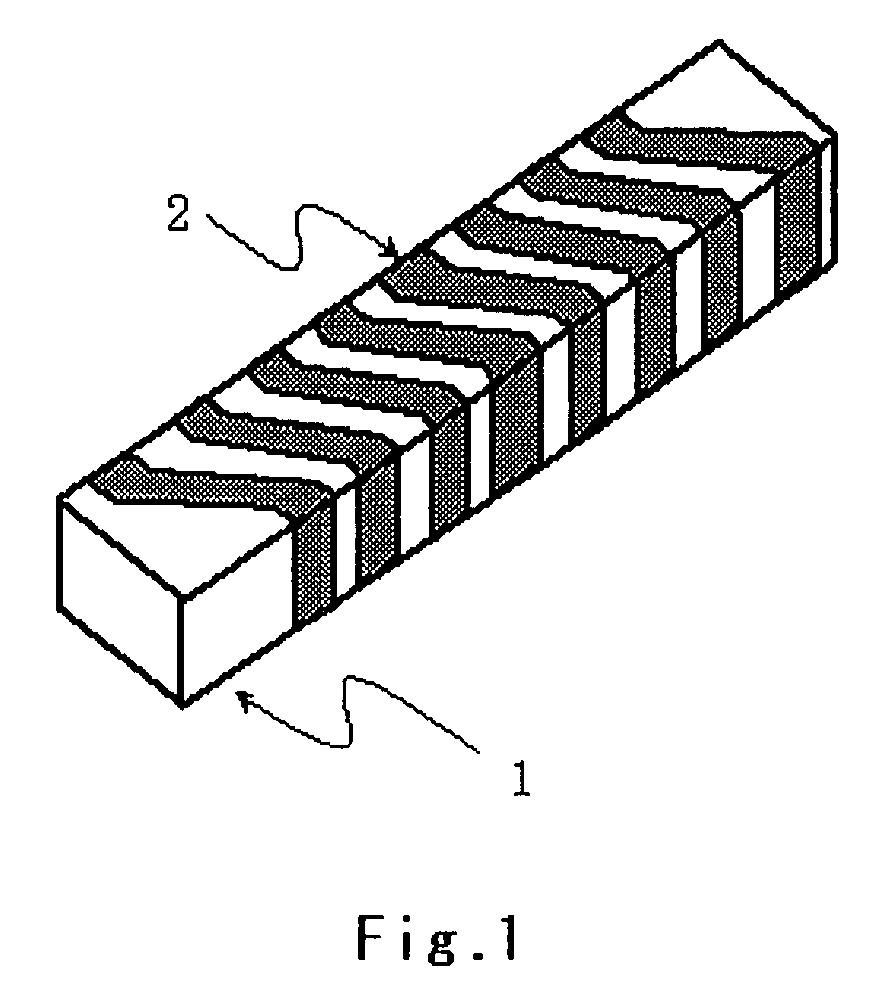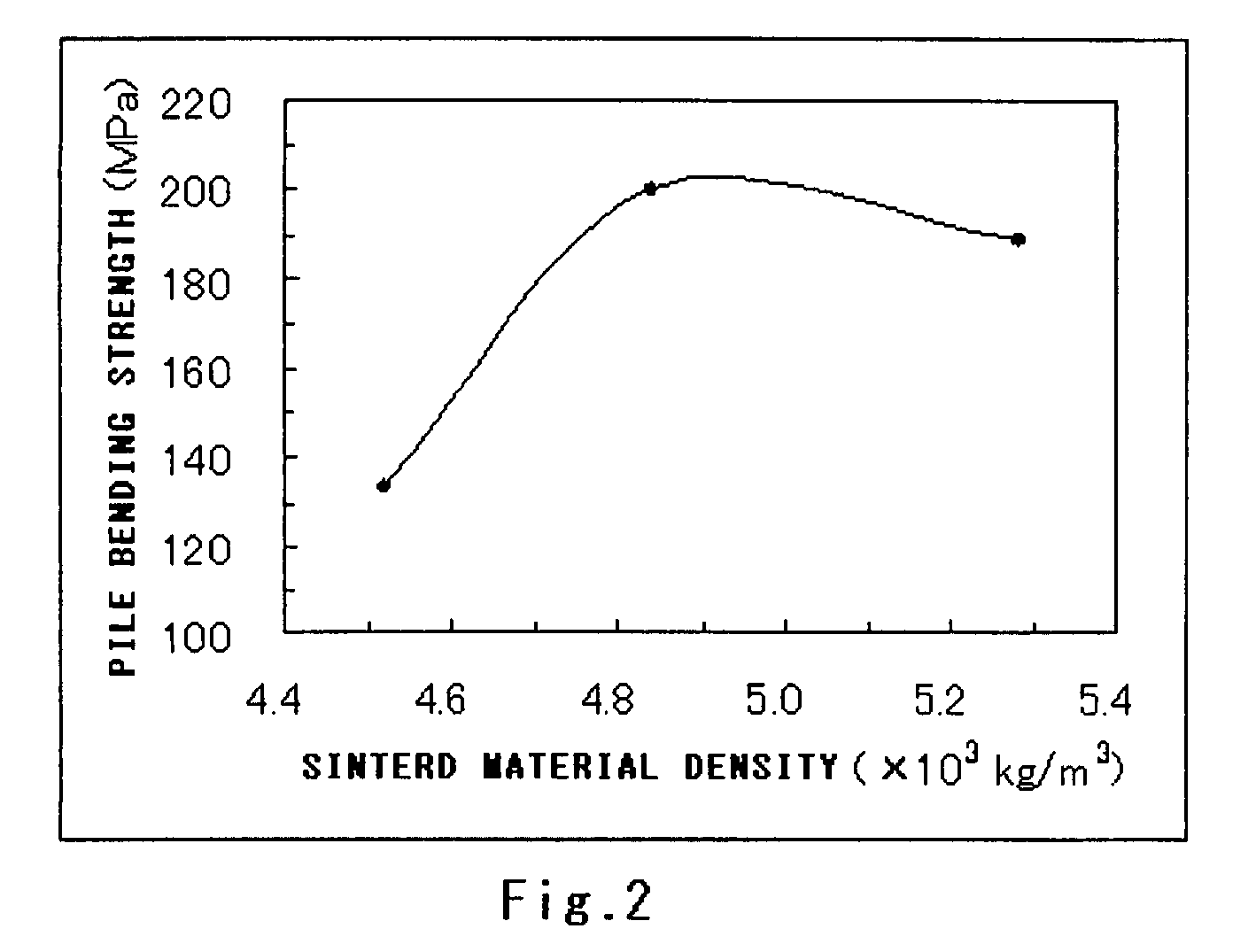Hexagonal ferrite, antenna using the same and communication apparatus
a ferrite and ferrite technology, applied in the field of ferrite, can solve the problems of reducing the reducing the permeability of magnetic permeability, and reducing the bandwidth of chip antennas, etc., and achieves excellent loss factor, high and excellent density of sintered body.
- Summary
- Abstract
- Description
- Claims
- Application Information
AI Technical Summary
Benefits of technology
Problems solved by technology
Method used
Image
Examples
example 1
[0047]Fe2O3, BaCO3, SrCO3, CO3O4 and NiO were weighed such that each oxide magnetic material had a predetermined composition shown in Table 2, and then SiO2, Na2CO3, Li2CO3 and Mn3O4 were added in the amounts indicated in Table 2 with respect to 100 weight parts of the main components, followed by mixing the thus weighed components in the wet ball mill using water as a medium for 16 hours.
[0048]The mixed powder was dried and then calcined in the air at 1000° C. for 2 hours. The resultant calcined powder was ground in the wet ball mill using water as a medium for 18 hours. The binder (PVA) in the amount of 1% was added to the resultant ground powder for granulation. Upon granulation, the resultant granules were compressed into a ring shape. Thereafter, the shaped granules were sintered in an oxygen atmosphere at 1200° C. for 3 hours. The resultant ring-shaped sintered body having an outer diameter of 7.0 mm, an inner diameter of 3.5 mm and a height of 3.0 mm underwent a process of me...
example 2
[0053]Sintered body were fabricated as in Example 1 except that the molar ratios of the main components Fe2o3, BaO (BaCO3 was used) and CoO (Co3O4 was used) were 60 mol %, 20 mol % and 20 mol %, respectively, and Li2CO3, CuO and ZnO were contained in the amounts indicated in Table 4 with respect to 100 weight parts of the main components. Table 4 shows the results of measurement of the density of sintered body, the volume resistivity, the magnetic permeability μ, the loss factor tan δ and the dielectric constant ∈ performed as in Example 1.
[0054]
TABLE 4VolumeMagneticDielectricLi2CO3CuOZnODensity ×resistivity ×permeabilityLoss factorconstant(Weight(Weight(Weight103105μtanδεNo.Part)Part)Part)(kg / m3)(Ω· m)(1 GHz)(1 GHz)(1 GHz)37Example0.20.404.843.42.80.055.138Example0.20.604.803.12.90.055.039Example0.21.305.200.42.70.045.340Example0.21.505.300.21.50.014.741Example0.40.405.181.12.90.064.842Example0.40.605.320.82.70.054.743Example0.41.005.132.02.80.044.944Example0.41.505.072.32.40.024.9...
example 3
[0056]Some of the materials in Examples 1 and 2 were used to fabricate block-shaped sintered body each of which was machined into a shape having a dimension of 15 mm by 3 mm by 3 mm. Ag—Pt paste was printed and sintered onto the surface of each of the sintered body to fabricate a chip antenna with an electrode having a helical structure configured such that the electrode width and the electrode gap were 0.8 mm and 0.5 mm, respectively, and the number of winding was eight. FIG. 1 shows the exterior of the fabricated chip antenna. Each of the chip antennas was mounted on a substrate and one end of the helical electrode was connected to a feeding electrode. Then, an antenna gain evaluation apparatus using a network analyzer was used to evaluate antenna characteristics (resonant frequency, full width at half maximum of gain). Table 5 shows the evaluation results. As shown in Table 5, each of the chip antennas using the hexagonal ferrite of this example achieved a maximum gain of −10 dB ...
PUM
| Property | Measurement | Unit |
|---|---|---|
| density | aaaaa | aaaaa |
| frequency | aaaaa | aaaaa |
| dielectric constant | aaaaa | aaaaa |
Abstract
Description
Claims
Application Information
 Login to View More
Login to View More - R&D
- Intellectual Property
- Life Sciences
- Materials
- Tech Scout
- Unparalleled Data Quality
- Higher Quality Content
- 60% Fewer Hallucinations
Browse by: Latest US Patents, China's latest patents, Technical Efficacy Thesaurus, Application Domain, Technology Topic, Popular Technical Reports.
© 2025 PatSnap. All rights reserved.Legal|Privacy policy|Modern Slavery Act Transparency Statement|Sitemap|About US| Contact US: help@patsnap.com



